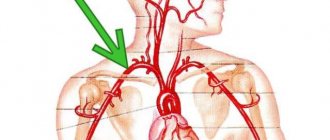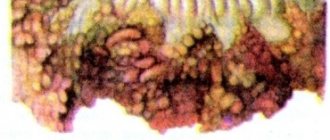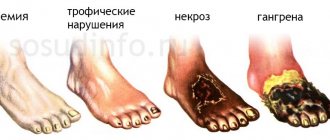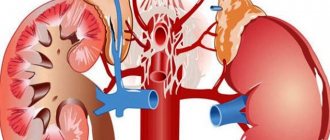About pathology
Asymmetry of blood flow through the vertebral arteries is a phenomenon in which the blood supply to the brain is disrupted due to dysfunction of the vertebral arteries.
Reference. The pathology is also known under such terms as vertebral artery syndrome, vertebrobasilar syndrome.
The blood supply to the brain is provided by 4 large blood vessels (carotid and vertebral). The vertebral arteries account for a relatively small volume of the total blood flow.
However, this circumstance does not mean that disruption of blood circulation in this area is not dangerous. Of course, the likelihood of developing an ischemic stroke in this case is negligible (it cannot be completely ruled out), but a significant deterioration in health, pathologies of the organs of vision and hearing, and even disability of the patient are very real consequences.
The mechanism of development of pathology goes through several stages and looks like this:
- Under the influence of a negative factor, obstruction and uneven blood flow in the vessels occurs.
- Disruption of the supply of nutrients and oxygen to the brain.
- The occurrence of symptoms requiring careful diagnosis.
When the first symptoms appear, you should definitely see a doctor, because if left untreated, the symptoms will only intensify, which will provoke the development of various complications.
Prevention
To avoid recurrence of problems with cerebral blood flow, a person who has undergone treatment needs to evaluate and, if necessary, radically change their lifestyle. First of all, you will need to diversify your daily life with feasible physical exercises, which will increase blood flow through the vertebral cerebral vessels. Quit smoking and frequent drinking, follow a healthy diet and monitor your own body weight. You will also need to regularly take vitamin supplements and medications that normalize the chemical composition of the blood.
Vessels
Decrease in Blood Flow in the Right Vertebral Artery and Normal Blood Flow Velocity
Feb 01, 2020 Kokh V. A.
55004
Vessels
Circle of Willis: Option for Development in the Form of Absence or Decreased Blood Flow, Treatment
Feb 01, 2020 Kokh V. A.
25432
Vessels
Causes
The development of blood flow asymmetry can occur for various reasons. Typically, this phenomenon occurs due to compression of these blood vessels.
Provoking factors for the occurrence of pathological phenomena include:
- congenital asymmetric development of arteries - uneven development of a pair of vessels and leads to asymmetry of blood flow. This disease cannot be cured today.
- birth injuries,
- tortuosity of the arteries - may be congenital or acquired,
- instability of the vertebrae of the cervical segment,
- osteochondrosis,
- the formation of tumor formations that compress blood vessels,
- intervertebral hernia,
- injuries.
The risk group includes people whose professional activities involve constant physical activity, sedentary work, as well as athletes.
The reasons for the occurrence and development of such pathology
If we talk about the reasons for which such a disease develops, then it is impossible to say unambiguously, since the pathology occurs in an individual form, and the reasons may also be different for different people. There are many factors that play a role in the development of the disease.
Most often, pathology of the spinal arteries develops for the following reasons:
- disorders of a congenital nature, that is, the arteries do not develop in the same order, which may well lead after a certain time to asymmetry of cerebral blood flow;
- The human cervical spine has various types of anomalies. If a person has problems with the spine, for example, we can take such a common ailment as osteochondrosis (intervertebral hernia and osteophytosis also often occur), then this can have an extremely negative effect on the supply of blood to the brain, which flows through the vascular trunks of the spine;
- the spine is injured in the neck area;
- there is tortuosity of the arterial type, this pathology is congenital in nature, that is, the elastic membranes of the vessel are present in the body in much greater quantities than collage ones. Not only does such a pathology almost always lead to negative consequences, but an ischemic stroke can also occur.
If we talk about the highest risk group, then here are those people whose spinal arteries have received various types of disorders. People who do not regularly engage in physical work, sports, and are generally physically inactive are also at risk of getting this disease. The work is sedentary, monotonous, and if, in addition, a person has bad habits (smoking cigarettes, drinking alcohol), then there is nothing strange in the fact that he develops this kind of pathology.
It should also be noted that among the patients diagnosed with this disease, there are many who have received a cervical injury in one form or another.
Symptoms
The clinical picture is varied and depends on the severity and nature of the pathology. It is important which area is affected - d or s, that is, in which of the 2 arteries there is reduced blood flow.
Reference. This is an important indicator, so experts in the diagnosis prescribe this point in this way - asymmetry of the vertebral arteries d >, s or d <, s.
But in most cases, when there is a circulatory disorder, the symptoms have the following characteristics:
- Intense headache of different localization.
- Dizziness.
- Nausea, vomiting.
- Noise, ringing in the ears.
- Increased blood pressure levels.
- Loss of consciousness.
- Fatigue, lethargy.
- Heartache.
- Feeling of tension, stiffness, pain in the neck.
- Visual impairment.
Symptoms become more pronounced after physical exertion, playing sports, staying in one position for a long time, or after throwing back the head.
As the pathology develops, the patient may experience mental disorders - irritability, unreasonable fear, sudden changes in mood.
What it is
Cervical migraine, as this syndrome is otherwise called, is caused by impaired cerebral circulation due to compression or blockage of the lumen of blood vessels. Excessive trauma to the vessels causes persistent spasm in them, and therefore the diameter of their lumen decreases.
The paired vertebral arteries, along with the carotid arteries, supply the brain with oxygenated blood. Anatomically, they exit the subclavian region through the bone canal formed by the processes of the vertebrae. At the point where they enter the cranial cavity, they connect with large vessels of the brain. The contact of the vertebral arteries along their route with the bone structures of the vertebra and soft tissues largely determines the disruption of their patency in pathology.
In older age, dizziness, imbalance and brief episodes of loss of consciousness are relatively common and are almost always labeled as “cervical spondylosis” without further specification or “transient ischemic attacks.” In fact, some of them are associated with the characteristic pathology of vertebrobasilar insufficiency.
The reason for the decrease in cerebral perfusion can occur in principle by a decrease in blood flow to the front or rear source. The result is what is called vertebrobasilar insufficiency or vertebral transient ischemic attack home. Usually the contralateral vertebral artery depends on the direction of movement of the triggers. All events cease immediately after restoration of normal head position, which is the main criterion for clinical diagnosis. Evolution is not constant, and the patient's compliance with the same events or events.
There are two main groups of causes of vascular disorders:
- associated with spinal pathology (vertebrogenic);
- more rare, not associated with bone formations of the spinal column.
The leading place among vertebrogenic causes is occupied by degenerative-dystrophic changes, among them. Protrusions and, characteristic of osteochondrosis, lead to displacement of the vertebrae and their processes, forming the canal of the vertebral arteries. Chronic inflammation of cartilage tissue can provoke the growth of bone processes - osteophytes, which injure the vertebral vessels.
Non-vertebrogenic causes include their abnormal course, tortuosity and branching. In these places, fibrous plaques form, which ulcerate over time. The speed of blood flow decreases, a blood clot forms over the wall defect, preventing the normal movement of blood to the brain. Adhesive processes in the walls of blood vessels after inflammation and trauma also narrow their lumen. Specialists pay special attention to birth injuries in children.
Often, several factors from different groups are involved in the mechanism of occurrence of vertebral artery syndrome.
The severity of symptoms is directly proportional to the degree of narrowing of the vessel. A clear clinical picture is characteristic of bilateral lesions of the vertebral arteries.
During the entire period of the disease, two stages are distinguished:
- Functional, due to reversible;
- Organic, which is characterized by deep ischemic damage to brain tissue.
The first stage of the disease is manifested by a triad of symptoms: headache, visual impairment and changes in the vestibular apparatus.
Headaches of a pulsating and burning nature spread from the back of the head to the forehead, usually from vascular pathology. When the doctor asks the patient to show the location of the pain, the movements of his hands resemble the process of removing a headdress. This is a characteristic feature of pain at the beginning of an attack. The pain intensifies when turning the head, after sleep.
Frequent manifestations of vertebral artery syndrome are loss of balance, unsteadiness of gait,.
Visual impairment is rare and consists of subjective vision, colored spots and decreased visual acuity.
Diagnostics
Before treating asymmetry of blood flow through the vertebral arteries, the doctor conducts a thorough diagnosis.
First, the doctor interviews the patient, finds out the nature of the symptoms, examines and palpates the back of the head and head to identify painful areas.
After studying the external signs of pathology, the doctor prescribes vascular studies using special equipment:
- radiography - allows you to determine the presence of pathological changes on the walls of blood vessels, their location and size,
- MRI - allows you to detect minor abnormalities in blood vessels,
- Dopplerography - helps to assess the condition of blood vessels and the nature of blood flow,
- angiography - reveals the size, length of the segment of the damaged artery and the degree of change in blood flow.
The latest diagnostic technique allows you to accurately determine the area of the vessel where pathological changes have occurred.
So, depending on the location, the pathology is divided into 2 types:
- asymmetry of blood flow along the intracranial segments of the vertebral arteries - damage to the blood vessels located inside the skull,
- asymmetry of extracranial sections - damage to blood vessels and segments located between the head and heart.
Determining this nuance is extremely important for prescribing an effective therapeutic regimen.
Segments of the vertebral arteries
The vertebral arteries are both intracranial (located inside the skull) and extracranial vessels (located between the skull and the heart), which are divided into segments (divisions):
- The prevertebral (extraosseous) segment originates at the subclavian artery and ends at the entrance to the VI cervical vertebra;
- Foramenal (cervical) - located in the area between the II and VI cervical vertebrae. This section is the largest and makes up 70% of the entire length of the artery;
- The extravertebral (cervico-occipital) section of the artery is located in the area of the transverse foramen and groove of the first cervical vertebra;
- Intracranial - has a length of 2.4 cm, originates in the dural ring and ends at the confluence of the vertebral arteries. This part of the artery is also called the intracranial segment, since at this point the vessel ceases to be extracranial, and begins to be considered a vessel of the intracranial section.
Treatment
Symptoms and treatment of asymmetry of the vertebral arteries are interconnected, because the choice of treatment methods will depend on the severity and nature of the manifestations.
Reference. Pathology is treated conservatively and under the supervision of a specialist.
The therapy is complex and includes the following treatment methods:
- Medication—various groups of drugs are taken:
- vascular drugs - help thin the blood and improve cerebral circulation,
- stabilizing agents - to eliminate fainting, dizziness, and other vestibular disorders,
- anti-inflammatory drugs - to eliminate pain and inflammation,
- neuroprotectors - to improve nerve conduction,
- metabolic drugs and vitamin complexes - to strengthen the body and stimulate metabolic processes.
- Reflexology.
- Autogravity therapy.
- Physiotherapy.
- Massotherapy.
- Manual therapy.
Surgery is performed only in cases where the cause of blood flow asymmetry is a neoplasm that mechanically compresses the vessel, thereby preventing blood circulation.











